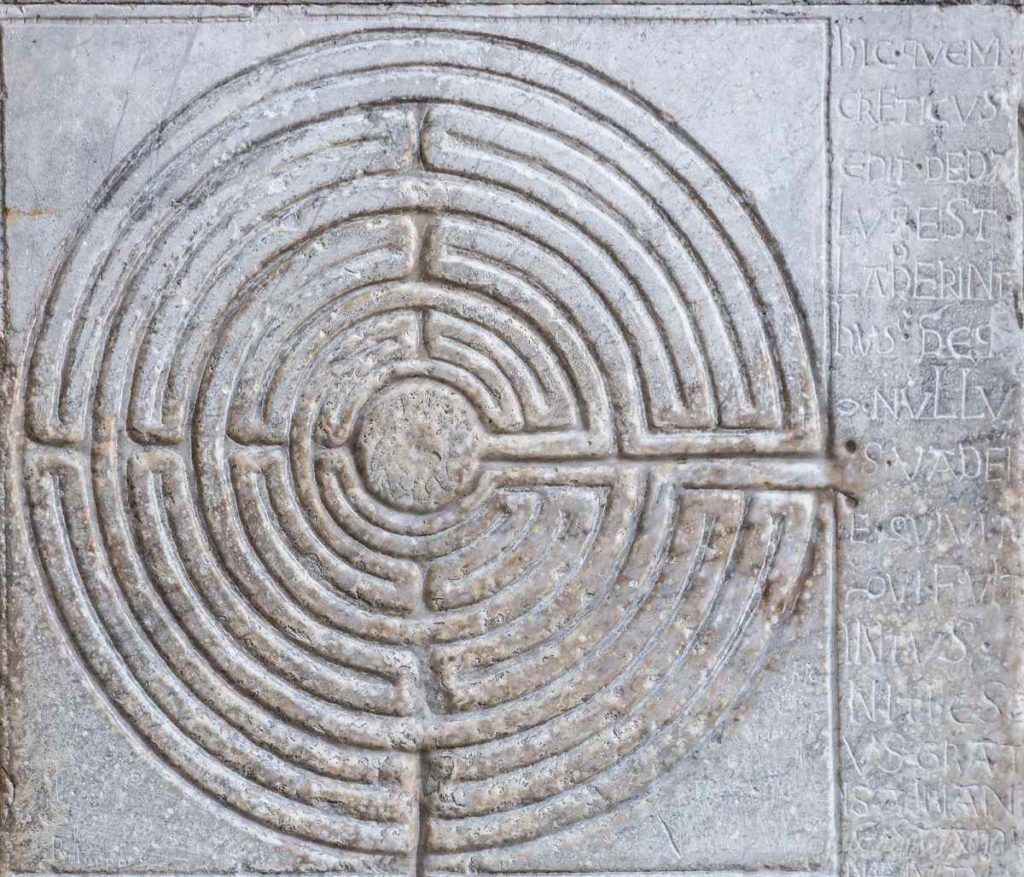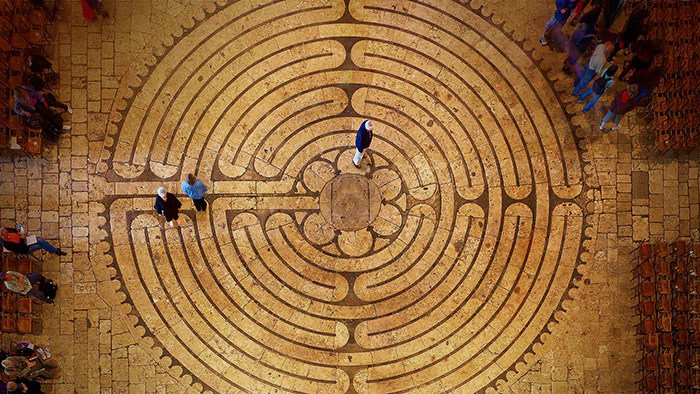
… and then, without knowing how or why, I found myself within the labyrinth of lights and shadows, which I had shown and explained to others countless times, without having ever entered it.
This almost seems to paraphrase the beginning of the famous tercet from Dante’s Divine Comedy where “the straight path was lost”. The analogy has often crossed my mind when thinking of the 12th-century labyrinth located on the pillar next to the bell tower of the Cathedral of San Martino.
I am a tourist guide of Lucca.
For at least twenty five years, I have shown this sculpted marble relief to thousands of tourists. I do not remember how many times I have narrated its tale and tried to explain its significance but always from the “outside”.
Then suddenly, without intending to, I found myself inside it. inside the labyrinth.
But let me start from the beginning.
The Sculpted Labyrinth
Seen from a distance, the labyrinth recalls a shooting target.
The circle is about 80 centimeters in diameter and within it, a path, in relief, twists and turns. From the outer limit you have the illusion of being able to quickly reach the center but then it recoils and goes back irremediably, like the coils of a snake.
Alongside the labyrinth, there is an epigraph relating the story of the origins of the pathway which apparently leads nowhere and has no solution.
It is written in Latin and is somewhat cryptic.
“Hic quem Creticus edit Daedalus est laberinthus de quo nullus vadere quivit qui fuit intus ni Theseus gratis Ariane stamine jutus”. (This is the labyrinth constructed by the Cretian Daedalus from which no one was able to exit save Theseus thanks to Ariadne’s thread).
In the front of one of the most important cathedrals of the “dark” period of the Middle Ages, we find the oldest myth of the Mediterranean, cradle of European culture.
It is not the only cathedral to have one.

The great Cathedral of Chartres in northwest France, built at about the same time as San Martino, has an identical labyrinth on the floor of its interior, 12 meters in diameter.
In fact, along the pilgrim route, many labyrinths, sculpted, painted, engraved, etched, can be found.
Various Interpretations of its Significance
As both churches are along the busiest section of the pilgrim route, from Canterbury through France to Rome, the majority of texts that talk about them and the labyrinths, speak of the latter in relation to the difficulties a pilgrim faced on his once-in-a-lifetime pilgrimage to pray at Peter’s tomb, Peter being the founder of the Christian Church. It was impossible to reach the true ultimate destination (represented by the center of the labyrinth where the Minotaur awaits), the Holy Sepulcher in Jerusalem, because it was occupied by Muslims and conquered by the “warrior Saladin” in 1187 as reported in another epigraph in Lucca found inside the Church of Santa Maria Nera.
I feel, however, that the many other common elements of these two churches, referring to the building techniques and skills of the masters that constructed them, must also be taken into consideration.
For example, if we analyze and compare the Duomo of Pisa with the Cathedral of Lucca, you can tell that the craftsmen that worked on them descended from a common root of which Master Buscheto (Buschetto, Busketus) was one of the first exponents. On the left hand side of the facade of the Duomo of Pisa, there is an epigraph, in Latin, commemorating Buscheto’s construction in 1063. Given his skill, ability, talent, intellect, and cunning, the master builder is considered superior to Daedalus and Ulysses, enough to build “a marble temple, white as snow, without equal”.
Despite the different dates of construction of the two churches (Pisa, 1063, by Master Buscheto and the façade, 1118, by Rainaldo, and Lucca, 1204, by Master Guidetto), the builders had similar ideas and building techniques, which were jealously guarded and passed on from generation to generation.
It is understandable, therefore, that these master builders drew a great deal from mythology and the classical forms of antiquity, but also availed themselves of techniques and theoretical speculations found in mathematics and geometry. These were kept highly secret and would be revealed only to a restricted circle of initiates.
There are, however, many other different interpretations and stories associated with this symbol, based on the person drawn to it, not just physically but mentally, almost intimately so.
How many times as children, when we saw films or read books and comic books, would we dream about becoming pilots, adventurers, leaders, great artists, etc., when we grew up?
So we set off, self-confident and with the best of intentions, to attain our goal but as we make our way through life, things happen and the path to our goal becomes nebulous and seems to grow longer while other possibilities come to light. The straight path begins to twist as we meet the first difficulties but thanks to unexpected moments of joy and success and the help of loved ones, we are able, for the most part, to overcome the problems.
Yet for some, at a certain point in their life, the difficulties, usually unexpected, seem insurmountable and feel like major setbacks.
Everything becomes dark. Pain, anger, helplessness, loss.
And it is in moments like these, that, sometimes, a tiny white dot appears far off in the darkness, an element of salvation, like a tiny seed we have left behind which bears fruit in front of our eyes and comes to save us from the darkness in the form of love.
Love for those that have left us, love for those who have stood by us in bad times and good, love in all shapes and forms, which transforms itself, within the eternal dimension of time and space, into eternal moments.
If we have ever had these feelings at all, the tiny white dot will become light and lead us out.
Perhaps I have already written this before, but years ago when I was a carefree young man, I chose this symbol as the logo of our tourist guide association, Turislucca.
And needless to say, the labyrinth and its location will always hold a special place in my heart.